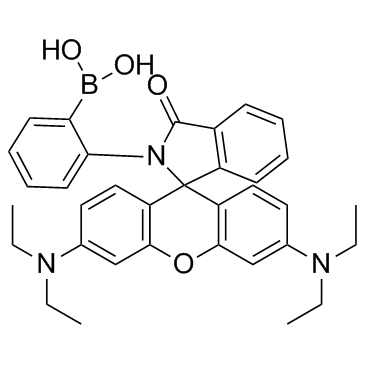| Description |
ATP-Red 1 is a multisite-binding switchable fluorescent probe, and can selectively and rapidly responds to intracellular concentrations of ATP in living cells.
|
| Related Catalog |
|
| In Vitro |
ATP-Red 1 is a multisite-binding switchable fluorescent probe, and can selectively and rapidly responds to intracellular concentrations of ATP in living cells. The maximum absorption and emission wavelength of are 570/566 nm and 590/585 nm. ATP-Red 1 has good membrane permeability, and in the presence of 5 mM ATP, the fluorescence intensity of ATP-Red 1 increases 5.6-fold. ATP-Red 1 (2.5 μM, 20 min) shows much weaker fluorescence after KCN-induced inhibition of OXPHOS, which results in reduced mitochondrial ATP levels in OSCC cells[1].
|
| Cell Assay |
OSCC Cells are plated in 96-well flat-bottomed plates at 1×105 cells per well and allowed to grow 3 or 24 h prior to exposure to ATP-Red 1. Then MTT reagent is added for 4 h at 37 °C and DMSO (100 μL/well) is further incubated with cells for 15 min after removing the medium. The absorbance at 570 nm and 690 nm (background signal) is recorded in a Spectra Max M2 microplate reader. The following formula is used to calculate the viability of cell growth: Cell viability (%) = (mean of A value of treatment group / mean of A value of control) × 100[1].
|
| References |
[1]. Wang L, et al. A Multisite-Binding Switchable Fluorescent Probe for Monitoring Mitochondrial ATP Level Fluctuation in Live Cells. Angew Chem Int Ed Engl. 2016 Jan 26;55(5):1773-6
|
